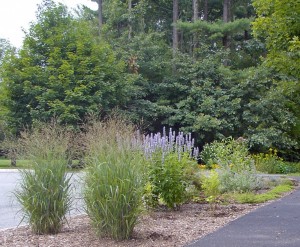Xeriscapes: Creating a Drought-Tolerant Garden
The word is Greek, the idea is Mediterranean and the result can save you water, time and effort. In New England, a xeric garden means choosing garden plants that are drought tolerant once established, using more natives, designing and planting your garden to minimize the need for water.
How do I make my garden drought tolerant? Start by improving your soil. In new beds add compost to the soil before planting. In existing beds, add compost as a mulch, or mix into the garden soil when planting. Compost increases any soil’s ability to hold water so rainwater, or water from you, is not lost.
 And speaking of water loss, keep your beds cool and moist with two to three inches of mulch (more than this amount will not allow the water to percolate down to the soil, less will allow water to evaporate out). Use mulch to create shallow saucers about 6 inches away from the stems of shrubs and trees. This will direct water you put on new plantings to the root zone by preventing it from spreading out. Weed frequently so that as plants become established so they don’t face competition for water.
And speaking of water loss, keep your beds cool and moist with two to three inches of mulch (more than this amount will not allow the water to percolate down to the soil, less will allow water to evaporate out). Use mulch to create shallow saucers about 6 inches away from the stems of shrubs and trees. This will direct water you put on new plantings to the root zone by preventing it from spreading out. Weed frequently so that as plants become established so they don’t face competition for water.
When you do water or irrigate, do it efficiently. Water early in the morning (before 9 a.m.) or after 8 p.m. Watering in mid-day can cause you to lose half your water to evaporation. Avoid automatic sprinklers but, if you must use them, shut them off during rain or after substantial showers. Make certain you are watering your garden and not your driveway, sidewalk or street.
Choose your plants carefully. Bulbs belong in every drought tolerant garden. These hardy flowers from Turkey need water in the fall and spring (when it usually rains in New England) but are unaffected by all but the very driest summers. Whether it’s crocus, daffodils, hyacinths or alliums, plant bulbs for color from early spring into summer.
Dry shade is not a problem once you have established astilbes and hostas which thrive throughout the summer. Only prolonged drought will stop sun loving summer bloomers such as black-eyed susans or yarrow. Clethra, Kalmia (Mountain Laurel), Buddelia, boxwood, viburnum are all bushes that provide beauty throughout the growing season be it wet or dry. Many trees such as spruce, pine, ash and oak can withstand even the driest years once they are established in a site. New England natives evolved in this climate and often offer low maintenance and deer resistance while being tolerant our climates extremes.
But what is meant by “once established”. Any new planting will need regular watering until it has put down sufficient roots to meet its water needs. For perennials, one season of consistent watering is usually long enough. For shrubs, it will take one year, two if you have purchased or moved a larger specimen. Trees need no less than two years of regular water, and maybe five or more, from the time the ground thaws in the spring until it freezes in the winter. Why so long? Depending on the size of the tree, it will take the roots two to ten years to grow to the size they would have been if the tree had never been disturbed. For this reason, small trees are often able to become established and grow fast enough to catch up with a large transplanted tree. Something to consider when tree shopping.
There are some plants that are just thirsty. If you are looking to reduce your water use, you probably will want to reduce the number of plants such as iris and maples which need lots of water throughout the growing season. Because we all love a few heavy drinkers, plant them together so you only have one area that needs regular watering
Plant trees that will provide shade for plants that don’t demand full sun, reducing their water needs.
Lawns are non-native plants that demand large quantities of water when rainfall is at its lowest. Consider how much lawn you really need and reduce the size of your lawn accordingly. While replacing a lawn with a large shrub bed may have higher upfront costs, the reduced maintenance, savings on chemicals and water used make it a bargain in a few years time. Allow lawns to go dormant in the heat of summer. Turning brown is not a sign of a dying lawn but of one using an evolved strategy to survive unfavorable conditions. Growing during high temperatures is highly stressful, often leading to more problems later. Overseeding existing lawns with less water-dependent mixtures is another water saving strategy.
Your xeric garden will be as bright and beautiful as any other. The secret is that it will save you water, money and work. And isn’t that something we all want in our gardens?